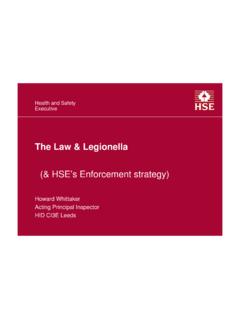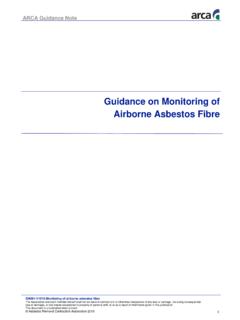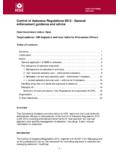Transcription of The storage of flammable liquids in tanks HSG176 …
1 Page 1 of 64 Health and Safety ExecutiveThe storage of flammable liquids in tanks This is a free-to-download, web-friendly version of HSG176 (First edition, published 1998). This version has been adapted for online use from HSE s current printed version. You can buy the book at and most good bookshops. ISBN 978 0 7176 1470 7 Price storage of flammable liquids can pose serious hazards, not only to people on site, but also to the emergency services, the general public off site, and to the book gives guidance on the design, construction, operation and maintenance of installations used for the storage of flammable liquids in fixed tanks operating at or near atmospheric pressure. It applies to new installations and existing installations where practicable, and to both above and below-ground fixed bulk storage tanks . The guidance is aimed at managers and supervisors involved in storing flammable liquids , but may also be of interest to designers and installers.
2 It is relevant to many industries, such as chemical petrochemical, pains, solvents and pharmaceutical. HSE BooksPage 2 of 64 Crown copyright 1998 First published 1998 ISBN 978 0 7176 1470 7 All rights reserved. No part of this publication may be reproduced, stored in a retrieval system, or transmitted in any form or by any means (electronic, mechanical, photocopying, recording or otherwise) without the prior written permission of the copyright for reproduction should be made in writing to: The Office of Public Sector Information, Information Policy Team, Kew, Richmond, Surrey TW9 4DU or e-mail: guidance is issued by the Health and Safety Executive. Following the guidance is not compulsory and you are free to take other action. But if you do follow the guidance you will normally be doing enough to comply with the law. Health and safety inspectors seek to secure compliance with the law and may refer to this guidance as illustrating good.
3 Material previously contained in The storage of flammable liquids in fixed tanks (up to 10 000 m3 total capacity) HSG50 1990 and The storage of flammable liquids in fixed tanks (exceeding 10 000 m3 total capacity) HSG52 1991 Health and Safety ExecutiveThe storage of flammable liquids in tanks page 3 of 65 Health and Safety ExecutiveContentsIntroduction 5 General 5 Scope of this document 5 Fire and explosion hazards 7 Legal requirements 8 Risk assessment 9 Control measures 9 Location and layout of tanks 13 General 13 tanks above ground 14 Separation distances for small tanks 15 Separation distances for groups of small tanks 16 Separation distances for large tanks 17 Separation from other dangerous substances 17 storage of flammable liquids in buildings 18 Underground tanks 19 Design and construction 20 The design of the tank 20 Corrosion protection 21 Installing the tank 24 Pipework to and from the tank 24 Tank connections and fittings 26 Valves 27 Pumps 27 Contents measurement 28 Vents 29 Emergency relief venting 30 Fire protection 30 Bonding and earthing 31 Bunding 32 Marking tanks and
4 Fittings 33 Lighting 34 Weather protection 34 Testing of tanks and pipework 34 Heated tanks 35 Loading and unloading facilities 36 Loading and unloading of road tankers 36 Transfer by rail 37 Operation of road and rail facilities 37 Inspection and maintenance 39 Permit-to-work systems 39 Modifying the storage installation 40 Decommissioning tanks 40 Demolishing tanks 41 Fire precautions 42 Fire-fighting equipment and facilities 42 The storage of flammable liquids in tanks Page 4 of 65 Emergency procedures 44 Security 45 Training 46 Higher-flashpoint liquids 47 Sources of ignition 47 Location of tanks above ground 47 storage in buildings 48 Venting 48 Marking and labelling 48 Road and rail tankers 48 Appendix 1 Legal requirements 49 References 55 Glossary 61 Further information 64 Health and Safety ExecutiveThe storage of flammable liquids in tanks Page 5 of 64 Health and Safety ExecutiveIntroductionGeneral1 This book gives guidance on the design, construction, operation and maintenance of installations used for the storage of flammable liquids in fixed tanks operating at or near atmospheric pressure.
5 It applies to new installations and to existing installations where reasonably practicable. It replaces HSG50 The storage of flammable liquids in fixed tanks (up to 10 000 m3 total capacity) and HSG52 The storage of flammable liquids in fixed tanks (exceeding 10 000 m3 total capacity). 2 The guidance is aimed at managers and supervisors involved in storing flammable liquids . It is relevant to many industries such as:n chemical;n petrochemical;n paints;n solvents;n may also be of interest to designers and installers. Trade organisations may wish to use the guidance as a basis for more specific guidance for their own This book gives help in the assessment of the risks arising from the storage of flammable liquids , and it describes measures to control those risks. Assessment, by employers and the self-employed, of the risks to workers and others who may be affected by their activities is one of the requirements of the Management of Health and Safety at Work Regulations 19921,2,3.
6 This publication also advises on how to comply with the relevant parts of the Health and Safety at Work etc Act 19744,5,6 and the Highly flammable liquids and Liquefied Petroleum Gases Regulations 19727-13, and with other relevant Legal requirements, guidance and the standards referred to in this guidance are listed in the reference section. They are subject to amendment from time to time. Where a British Standard is quoted, any other national or international standard which provides an equivalent level of safety is acceptable. The glossary at the back of this book explains the particular terms used in this guidance. Scope of this documentWhat this guidance applies to5 This guidance applies to flammable liquids with a flashpoint of 55 C or below. This includes all highly flammable liquids (as defined by the Highly flammable liquids and Liquefied Petroleum Gases Regulations 19727) and all petroleum spirit and petroleum mixtures as defined in the Petroleum (Consolidation Act) 192814 and the Petroleum (Mixtures) Order 192915.
7 It includes all liquids that are classified as flammable , highly flammable or extremely flammable for supply according to CHIP: Chemicals (Hazard Information and Packaging for Supply) Regulations 199616-20. 6 The guidance is also relevant to liquids with a flashpoint above 55 C which are stored at temperatures above their flashpoint. 7 Some of the precautions described may not be necessary for liquids with a flashpoint in the range 32 55 C and stored at ambient temperature. Advice on less restrictive measures for these liquids is given in paragraphs 223 235. Where The storage of flammable liquids in tanks Page 6 of 64 Health and Safety Executiveno variation is given, the advice in the main text The guidance applies to above and below ground fixed bulk storage tanks . It applies to premises where flammable liquids are stored in individual tanks or groups of tanks . It may also be applied to portable or skid mounted vessels with capacities in excess of 1000 Advice is provided on transfer facilities for road and rail loading and the guidance does not apply to10 The guidance does not apply to:n flammable liquids stored in portable containers and drums with capacities of 1000 litres or less.
8 These are covered by HSG51 The storage of flammable liquids in containers8. Generally, the storage of flammable liquids in fixed bulk tanks is preferable to storage of the same quantity in drums or similar containers, as spillage during handling is reduced;n liquids with a flashpoint between 21 C and 55 C but which do not support combustion when tested at 55 C, in the manner described in Schedule 2 of the Highly flammable liquids and Liquefied Petroleum Gases Regulations 19727;n flammable liquids which present special hazards requiring specific storage conditions, such as ethylene oxide, peroxides, and other liquids which entail a risk of rapid decomposition, polymerisation or spontaneous combustion;n petroleum kept in fixed tanks at retail filling stations. Guidance on filling stations and similar private premises is available in HSG146 Dispensing petrol: Assessing and controlling the risk of fire and explosion at sites where petrol is stored and dispensed as a fuel21;n carriage of flammable liquids (on or off site), including temporary storage at lorry parks and transit areas; n liquefied petroleum gas and other substances which are gases at ambient temperature and pressure but are stored as liquids under pressure or refrigeration; n flammable liquids stored under pressure.
9 In these cases the guidance on LPG storage22 may be appropriate;n vessels, which are an integral part of process plant; n loading and unloading of ships. This is covered by Guidance Note GS40 The loading and unloading of flammable liquids and gases at harbours and inland waterways23, Released vapours arising from the storage of flammable liquids can have environmental consequences and may be subject to controls under the Environmental Protection Act 199025,26,27. Although this guidance does not attempt to cover environmental issues, the advice it contains for the safe storage of flammable liquids will also provide protection for the environment. Further guidance is available from the Environment Agency, the Scottish Environmental Protection Agency or from local authorities, who enforce the Environmental Protection flammable liquids can also pose a health hazard if they are inhaled, ingested or come into contact with skin or eyes.
10 Information on the health hazards of a particular liquid , and on any specific precautions required, should be obtained from the safety data sheet17 or from the supplier. The Control of Substances Hazardous to Health Regulations 198828,29 require employers to assess the risks from exposure to hazardous substances and the precautions needed. The storage of flammable liquids in tanks Page 7 of 64 Health and Safety ExecutiveFire and explosion hazards13 The main hazards associated with the storage and handling of flammable liquids are fire and explosion, involving either the liquid or the vapour given off from it. Fires and explosions are likely to occur when vapour or liquid is released accidentally or deliberately into areas where there may be an ignition source, or when an ignition source is introduced into an area where there may be flammable Common causes of such incidents include:n inadequate design and installation of equipment;n inadequate inspection and maintenance;n failure or malfunction of equipment;n lack of awareness of the properties of flammable liquids ;n operator error, due to lack of training;n exposure to heat from a nearby fire;n inadequate control of ignition sources;n electrostatic discharges;n heating materials above their auto-ignition temperature;n dismantling or disposing of equipment containing flammable liquids ;n hot work on or close to flammable liquid Combustion of liquids occurs when flammable vapours released from the surface of the liquid ignite.







